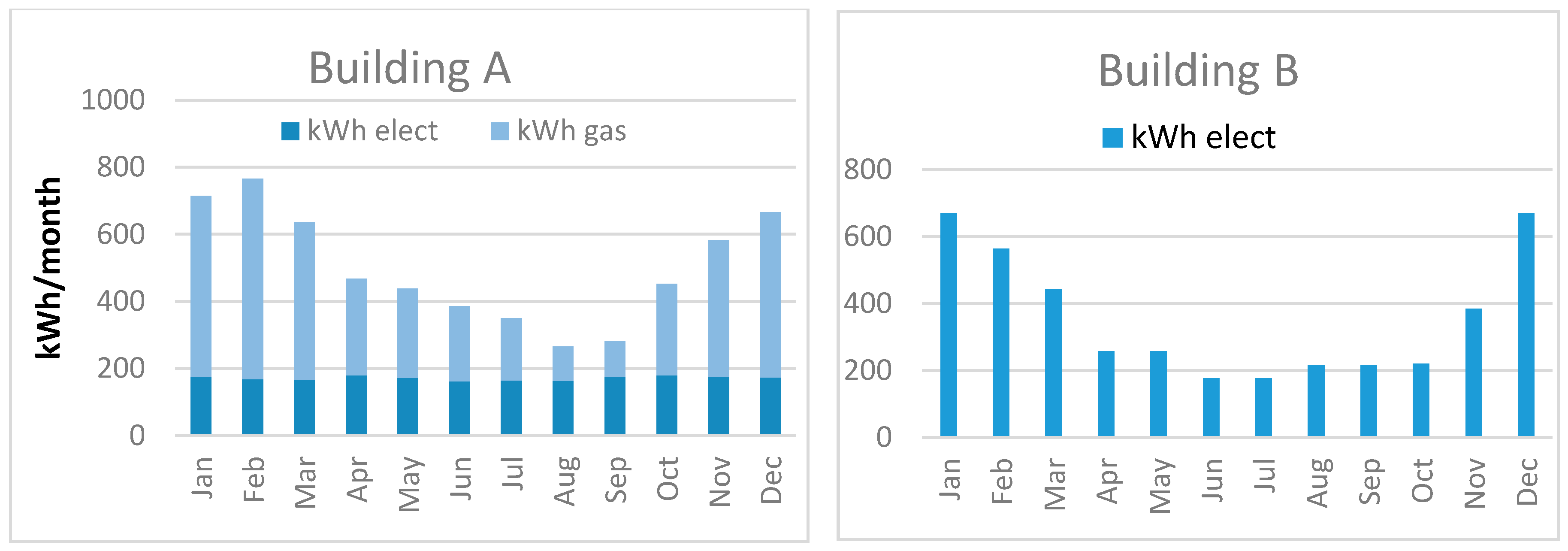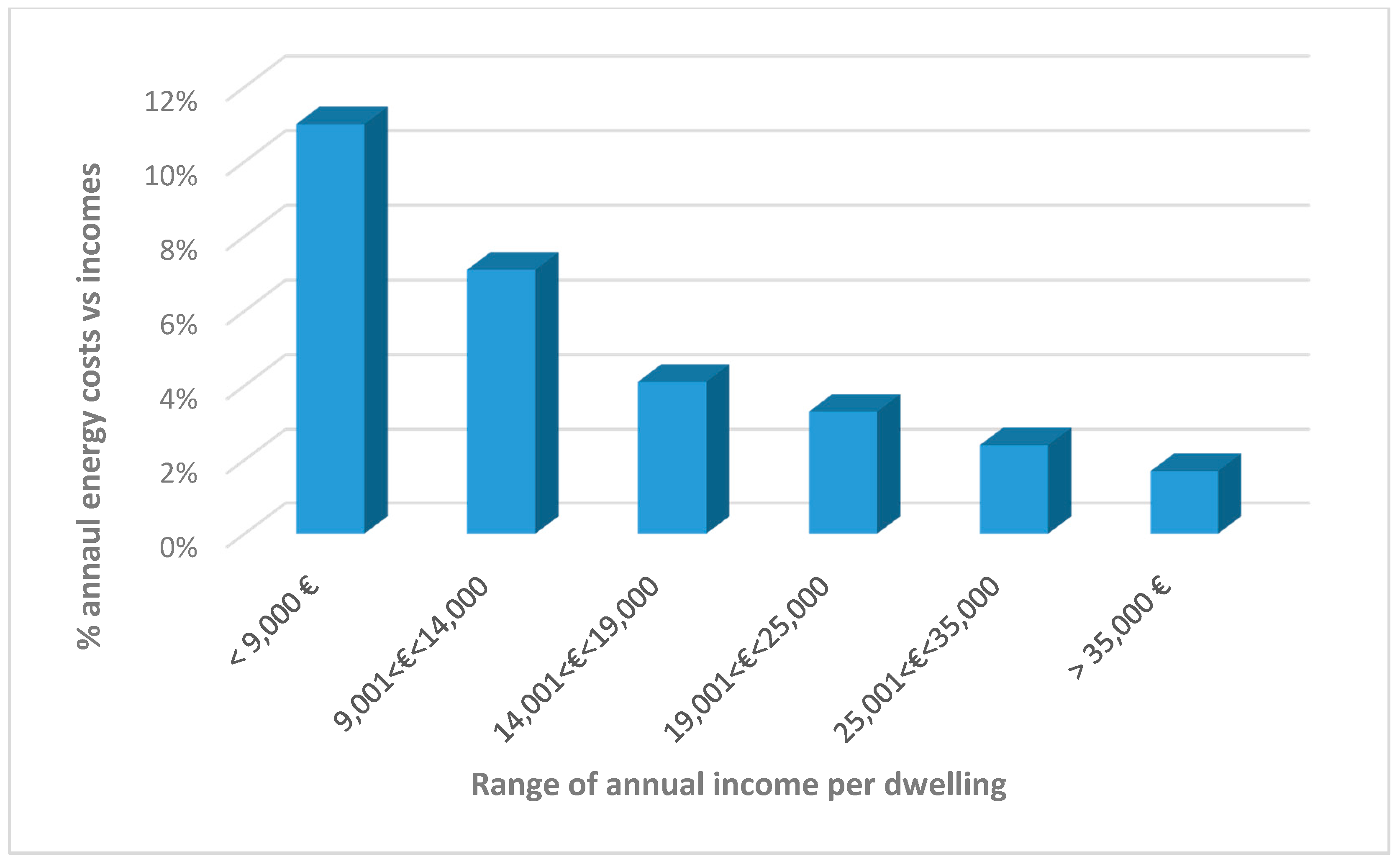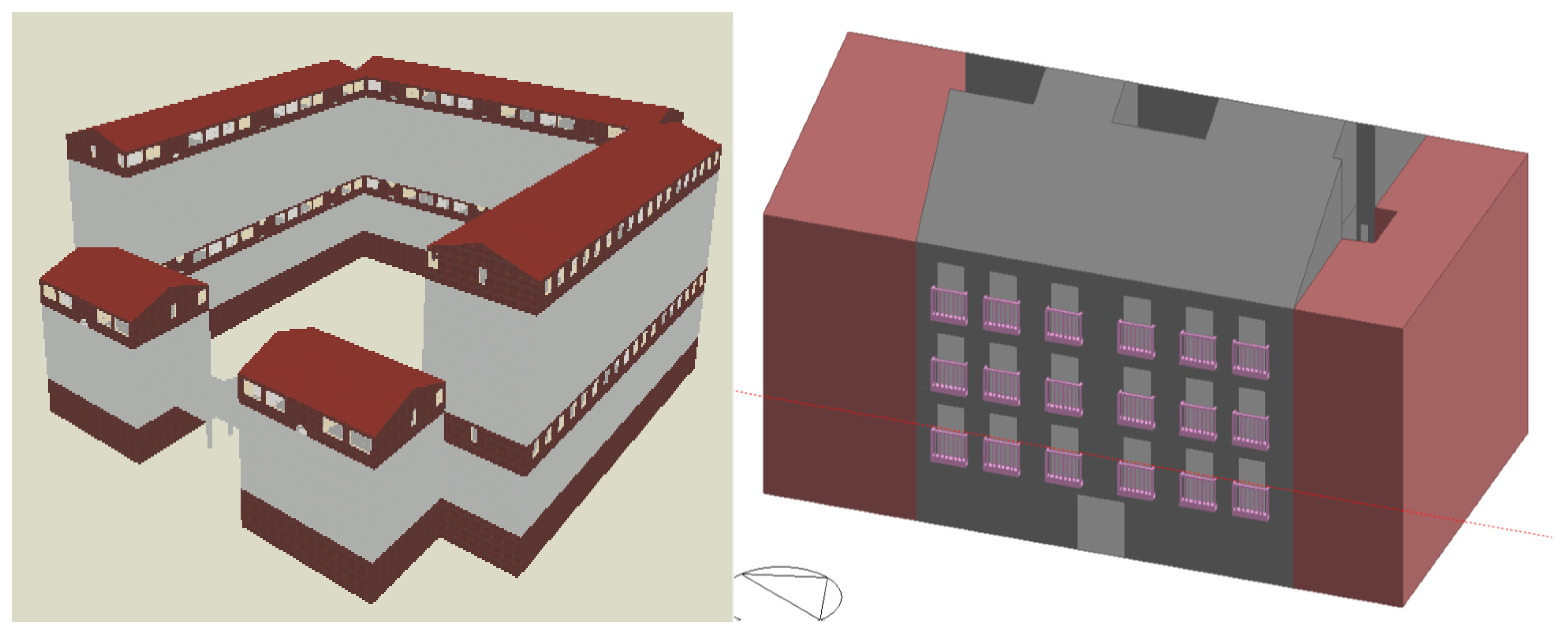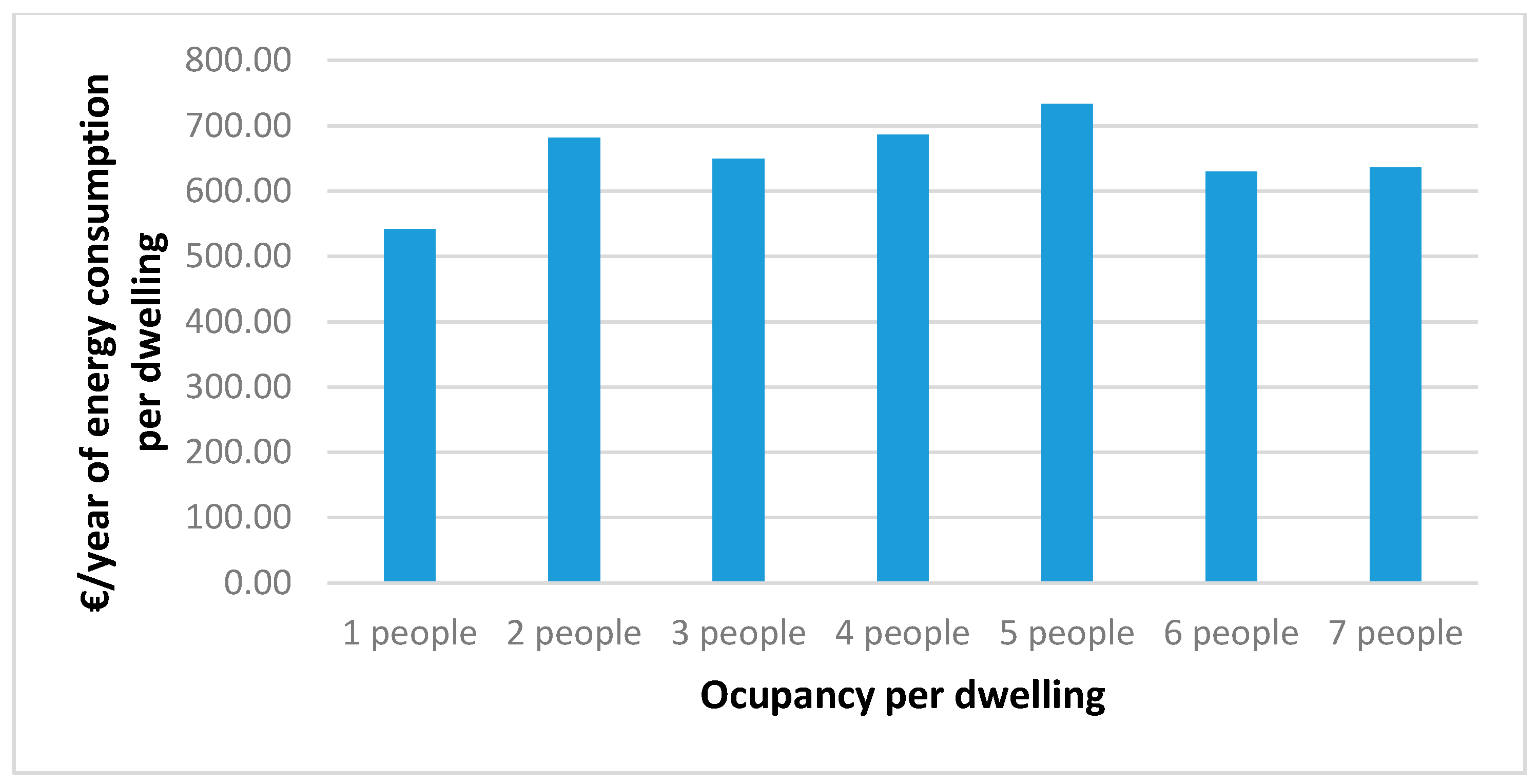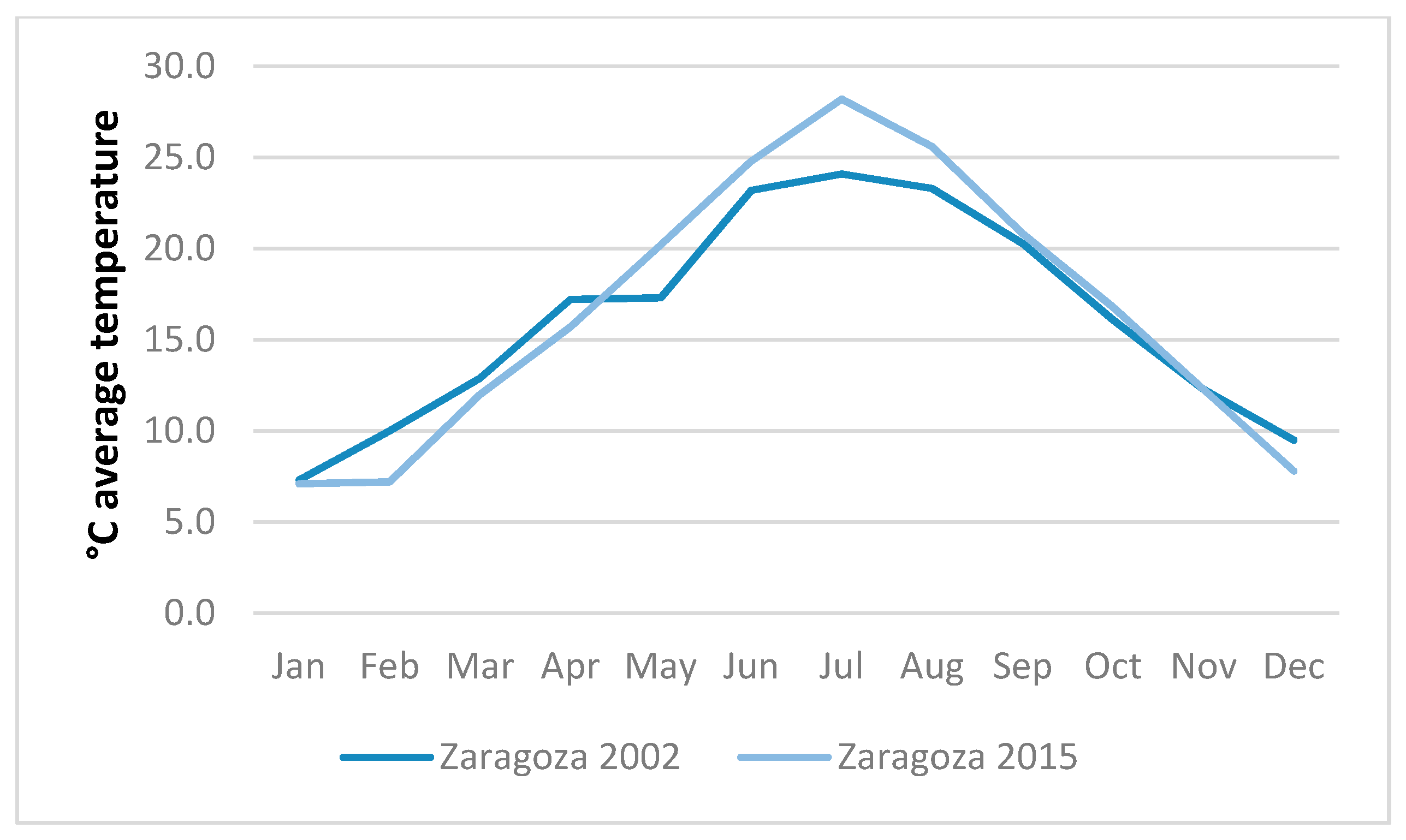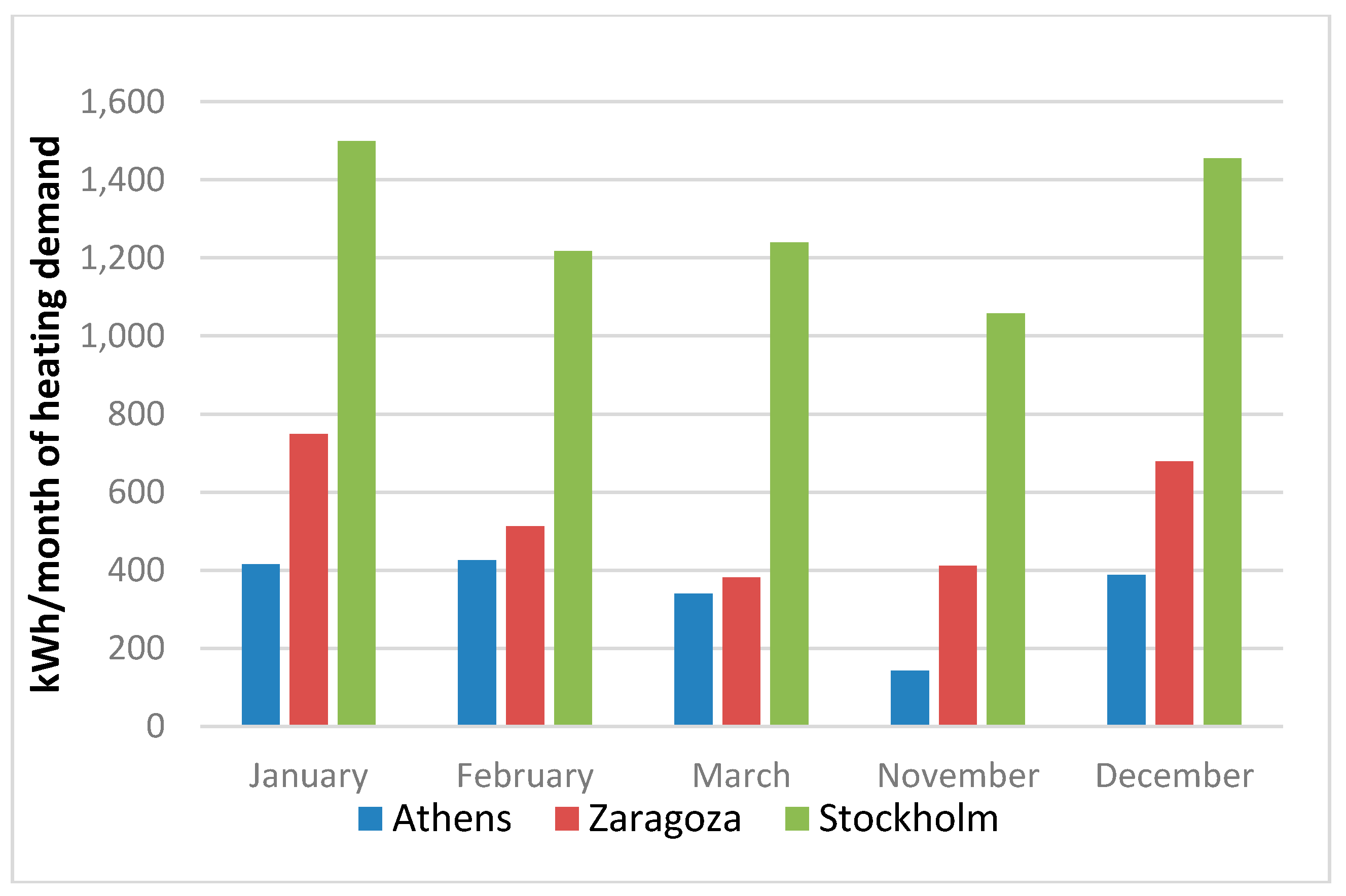1. Introduction
For most EU member states, there is a general consensus nowadays that energy poverty in households is a top priority which should be addressed to avoid social exclusion. This issue has been tackled by ensuring that most citizens can access energy at stable and affordable prices [
1]. Indeed, the European Commission in the recent “Winter Package” (2016) [
2] has acknowledged this issue. The issue of energy poverty is more severe in Southern and Eastern Europe [
3]. Despite more favourable climatic conditions in Southern Europe, 16.6% of households in the Mediterranean region live in conditions characterised by poor thermal comfort; in contrast, the European average is 4% lower [
4].
Owing to its importance for policy-formulation purposes, energy poverty has been defined by many authors [
5]. The International Energy Agency [
6] states that a household is in a situation of “energy poverty” when it has to pay energy costs which are excessive compared to the total household income. The definition provided by the International Energy Agency (IEA) is very similar to that adopted by the Environmental Sciences Association (ACA) in a pioneering Spanish publications [
7]. Energy poverty is a particular type of poverty which is principally determined by various factors [
8]: the ratio of minimum annual energy expenditure to income in a household [
9], the energy efficiency of buildings [
10], and finally the (more subjective) perception of comfort level in the dwelling [
11]. Authors such as Rudge [
12] establish this adequate level of comfort in a dwelling as an indoor temperatures ranging between 18 °C and 21 °C in winter, and a constant humidity level ranging between 20% and 80% of relative air humidity. Comfort level is affected by the clothing of the residents, the air speed and the level of physical activity and can only be expressed statistically by means of psychometric diagrams, due to the subjective nature of this parameter [
13].
These definitions include a subjective component, such as the thermal comfort level or satisfactory living conditions. To solve this issue, Grevisse and Brynart [
14] define “energy poverty” as the inability of a household to meet its certified energy needs. In this case, the subjective component means that an assessment and certification by a competent Public Body is necessary, as this body can confirm and classify the degree of vulnerability of the different households in terms of energy [
8]. In Spain, this evaluation and certification is provided locally by regional Public Social Services.
Based on the fundamental contribution by Boardman [
15], we applied the following information in our study: the use of 10% of net income to sufficiently meet energy needs is used as an index to detect households living with energy poverty. This figure was also applied by Taylor [
16], who introduced into the debate the definition of “energy poverty” [
17]. This threshold of 10% of annual net income being used to cover basic energy expenditure is a clear and measurable limit, and has been used in this present study to identify energy poverty in social housing.
Certain structural aspects of the global energy system help to sustain energy poverty, according to Sovacool [
18]. In general terms, a higher number of cases of energy poverty may occur among groups living in social housing, mainly due to the lower average level of income of these households. The influence of energy poverty on social housing has been studied by several authors in different countries, cities and climate zones such as in Australia [
19], the United Kingdom [
20,
21], the Netherlands [
22], and in several areas of Spain [
10,
23,
24].
Social housing is also a useful area of study in terms of examining the usage habits of the residents, specifically the comfort temperature target or the heating schedules. These users’ patterns make them different from the average urban households of European cities, according to Teres-Zubiaga et al. [
10] and Hui Ben and Steemers [
25]. The report “Energy poverty and vulnerable consumers in the energy sector across the EU: analysis of policies and measures” by the European Commission [
26] indicated that social housing has been the main focus of several initiatives, perhaps because of the high level of energy poverty of its occupants (this is in line with the conclusions reached by Hills [
9] and Li et al. [
27]).
Energy-simulation tools have been mainly applied when refurbishment of social housing is being analysed, as energy refurbishment has a greater social impact in those cases where residents are living with energy poverty [
11]. Despite the many improvements in computer-simulation techniques, the specificities of social housing still cause variations between the results obtained by computer simulation and the actual energy consumption in these dwellings, as Tronchin and Fabbri [
28], Wang and Zhai [
29] and Escandón et al. [
30] have pointed out. These differences may not be of great import in, for example, the energy certification of buildings, where the object of the study is a building which is generally compared to a reference building with similar characteristics, geometry, occupancy, use, and which is built in areas with the same climatic conditions. However, these differences are very important when simulation is carried out to assess the energy savings and benefits associated with building refurbishment and related investments [
31], or to define the priorities of public bodies providing subsidies for social housing based on the buildings’ energy performance [
32]. Ramos et al. [
33] state that the differences in energy performance are mainly related to specific social housing constraints. Efficient technologies alone cannot fix the problem, unless these technologies are adequately combined with an understanding of sociological aspects [
34].
Energy simulation is a widely extended tool which is used to assess energy performance in a building; it could also be used to evaluate energy poverty. However, using the simulation results with predetermined user profiles to assess the root causes of energy poverty, or to note energy-efficient refurbishment measures, may lead to important errors [
31].
This study analyses the application of energy-simulation tools to a sample of social housing in Spain. The main contribution of this article lies in the comparative analysis of real patterns of energy consumption in social housing. This analysis was undertaken to identify the variables that influence the level of energy poverty of these households and the causes of deviations in the data (computer simulations vs actual data). The obtained results can be used to improve the accuracy of the energy-performance simulations of a building of social houses: a characterisation of users’ patterns in buildings, where most of the households are somehow affected by energy poverty, can thus be undertaken [
35].
The article comprises two analyses. The first is an empirical analysis of energy-consumption patterns and energy-poverty assessment in a sample of social housing in Spain. The second analysis focuses on the use of energy-simulation tools to assess energy poverty (applied to the same sample). We will also take into account the limitations of these tools when studying social housing in Spain, and make recommendations based on our in-depth study of the issue of energy poverty.
2. Methodology
Cases of energy poverty are associated with households in the present study. For our purposes, the household is the analytical unit with which we aim to tackle energy poverty. This approach is in line with that of Webb et al. [
36].
Buildings play a major role in energy demand. For each specific climate, the energy demand of a building is related to the construction of the building and depends on factors such as materials, insulation, as well as the building’s geometry and the level of exposure to wind and sun radiation. Fully dedicated social housing building units are considered in the analysis. To discriminate energy poverty cases, a threshold of 10% of total annual income being used to satisfy energy needs, as postulated by Boardman [
15], was applied here. This index is easy to calculate using the available data and allows us to consider the relationship between excessive energy costs and household net income.
The first step for this study involved setting the selection criteria used to search for social housing samples. Buildings had to be homogenous in terms of their age, construction, maintenance and management, function and the climate of their setting. Two blocks of fully dedicated social housing apartments were selected (noted as buildings A and B). They are located in the city of Zaragoza (Spain) and are of public ownership; they are managed by the municipal company “Zaragoza Vivienda”, which reports to the Zaragoza City Council. Both buildings are subject to the same climatic conditions, were built at the same time in 1988, and are close to the average municipal housing stock age (from 1985). They have the same maintenance policy since they are publicly owned, and are used for the same purpose (public social housing for rent).
Two types of complementary and comparative analyses were performed in the present study: an empirical analysis which was used to analyse energy poverty in the sample based on actual energy consumption data, and an energy-performance simulation which was used to validate this approach as a tool with which to assess energy poverty.
2.1. Empirical Analysis
An empirical analysis of the data for each building was undertaken to characterise the energy consumption associated with this type of social housing. Four main types of variables have been studied: building envelope and geometric characteristics, energy-consuming equipment, energy sources and energy consumption, and household structure and consumption patterns (
Table 1).
The public company managing the buildings provided data on building materials and construction details, refurbishments carried out to date and the precise dimensions of the various floors and rooms (Subsections 1 and 2 in
Table 1).
A survey addressed to the building residents, which included socio-economic questions, was designed and distributed to all households. The questionnaire included questions about the household structure, residents’ employment and social situations, energy usage habits, the residents’ schedules and the intensity of use of the energy-consuming elements (Subsections 3 and 4 in
Table 1).
In total, 36 households out of 160 participated in the survey in building A, and 8 out of 12 participated in building B. The obtained sample was validated against the following criteria:
The different occupancy levels of the dwellings had to be taken into account, to permit us to study the effects of family structure and occupancy. The sample includes between two and six dwellings for each occupancy level (from one to seven people).
The different orientations of the buildings and the types of dwelling in each building were accounted for. Building B has three floors with four different types of dwellings per floor: two north facing and two south facing. The sample includes two dwellings of each type, distributed over three floors.
In addition, a detailed energy audit of two dwellings was carried out for each building analysed to confirm and extend the available data for the dwellings. This audit included a visit to the dwellings to measure and collect data on the indoor temperature, relative humidity, thermal transmittance of the building envelope and details relating to the residents’ energy-consumption habits such as their schedules, their usage of HVAC equipment, as well as the number and type of household appliances.
2.2. Energy Simulation
Energy simulations using computer tools and reputable commercial databases were carried out on these social housing buildings. The EnergyPlus calculation engine was used along with the DesignBuilder V4.7 (Stroud, Gloucestershire, UK) interface [
37]. The characteristics of the building and its enclosures, the equipment of the building and an average-user profile were modelled based on survey data and data supplied by the management company. Three different user profiles were created, according to the most common schedules registered: Families with 4 members, adults working full-time; families with 4 members, adults unemployed; and families with 2 members, adult(s) working part-time.
Finally, the simulation model was validated by comparing simulation results with actual energy consumption. Significant differences were noted, and, on this basis, we revised the model input parameters to fine-tune the model. A sensitivity analysis that included several model parameters was completed to assess the margin of error when using inaccurate input data. The user profiles and thermal comfort levels [
38,
39] received most attention, and we took into account the type of housing analysed.
Figure 1 summarises schematically the methodology followed in this study.
3. Case Study
Social housing in Spain has particular characteristics, both in terms of the buildings themselves and in their maintenance. A large percentage of these residential buildings were built prior to the implementation of the first energy-efficiency regulations in buildings [
30]. As few major retrofitting works have been carried out, these buildings usually have little or no insulation. Owing to the mild winter climate of the region and the poor gas-grid development at the time of construction, heating systems are individual and usually run on electricity. Public social housing, which constitutes a small proportion of the total social housing stock [
40] is well maintained and managed by the public authorities (usually municipal); there is no evidence that private social housing undergoes regular maintenance or building upgrades owing to the low rent of this type of housing.
Two buildings have been chosen for this study because they are homogeneous and representative of social housing in the city of Zaragoza (Aragon region of Spain); they also present interesting differences, mainly in relation to their size and HVAC equipment. The two buildings consist of individual apartments for residential use, with levels of occupancy generally ranging between one and seven people on low income. The dwellings are between 40 and 70 m
2. The buildings were built in 1988; at that time, few energy-efficiency criteria were contained in the regulations [
41]. All the dwellings are in the same climatic zone (mild Mediterranean). Building A is a group of blocks with 160 dwellings over eight floors, while building B consists of a single block of twelve dwellings over three floors. Another relevant difference is the individual heating system that runs on gas boilers in building A, and electric resistance radiators in building B.
Many family units have been subject to detailed attention by public social services, and, in some cases, they have received additional emergency aid to cover the minimum expenses of housing (mainly rent), and energy expenses, as well as other basic needs.
The climate in Zaragoza is dry and continental Mediterranean with very low rainfall, mild winters and hot summers. The average temperature is 15.5 °C. The registered number of annual Heating Degree Days (HDD), using a reference temperature of 15 °C [
42], is 1177 HDD (Degree days calculated using
www.degreedays.net). The average wind speed is 19 km/h. The predominant wind is cold and dry, blowing in a Northwest–Southeast direction [
43].
Table 2 describes the building characteristics, which are relevant from an energy-performance point of view.
From the point of view of construction quality, both buildings have no thermal insulation, but both comply with the Basic Norms of Buildings in force in the year of construction [
41]. Transmittances values of the main enclosing areas are shown in
Table 3, along with the limits of the current building regulations CTE DB HE1 [
44] corresponding to the climatic zone D3 (“D” indicates the winter-weather severity on a scale from A to E and “3” indicates the summer weather severity on a scale of 1 to 4). Looking at the value of the transmittances, building B exhibits better enclosure quality. A recent refurbishment of building B improved insulation, and adapted it to the aforementioned regulation.
As for the structure of the households in each building, there was a higher level of average occupancy in building A than in building B. There was more average living space per person in building B (28.5 m2/person) than in building A (18.5 m2/person) despite the smaller size of the average dwelling.
A similar average level of income was noted for households in both buildings, as shown in
Table 4. The level of income was slightly above the “poverty threshold” established in Spain at €7961/year for a one-person household, according to the 2015 Living Conditions Survey by the National Institute of Statistics [
45]. The income level is also below the “poverty line” for four-person households in Spain (€16,719/year), and well below the average income of households in Zaragoza, which is €24,336/year [
46]. However, a few relatively high values strongly distort this distribution, as 38% of the households in building A and 25% in building B are living below the poverty line [
45].
Energy poverty is a type of economic poverty that affects the basic consumption of households. The main cause of energy poverty is a lack of economic resources, as has been noted in Scarpellini et al. [
8]. The number of employed household members significantly affects the energy consumption of households: it is higher in building A (0.7 employed per household vs 0.4 in building B), but it should be noted that those employed in building A earned lower average wages.
Regarding the equipment, neither of the two buildings has summer cooling systems, and residents use natural and mechanical ventilation to improve their thermal comfort at home. This lack of cooling equipment is common to all social housing in Southern Europe [
47]. The demand for heating takes place over longer periods, carries more health risks and produces a greater sense of dissatisfaction in its absence than an absence of cooling. In addition, there are alternative solutions to a lack of cooling equipment, such as ventilation during cooler hours, limiting thermal gains with curtains and blinds, and the potential to act on parameters such as “activity”, “clothing”, and “humidity” with evaporative coolers, and the “speed of air” using fans. Therefore, although there is a demand for cooling in both buildings, no consumption derived from cooling was considered.
For heating and Domestic Hot Water (DHW), building A has 24-kW individual gas condensing boilers, with a rated throughput of between 87.8% and 92.8%, depending on the type, and a variable operating schedule which is set individually by each user. These boilers are gradually replacing the original gas boilers with a nominal throughput of 72%. Each dwelling has a central thermostat that regulates the heating, and manual valves to open and close the radiators of each room. During the energy audit, it was possible to verify that the lack of maintenance produced lime deposits in the valves that impeded the correct operation of the valves. The gas supply is individual and may also be used in the kitchen, although most of the residents have electric glass-ceramic cookers. The rest of the energy consumption is related to electrical equipment.
Building B has individually-manoeuvrable resistance electric-heating systems. The DHW is provided by individual electric-resistance tanks of between 30 and 70 L capacity. In addition, households own a variety of portable electric-heating apparatus. This led to a larger electrical power-supply capacity in building B, where the average is in 5.6 kW of contracted power compared to the average 3.5 kW in building A. This increased the fixed energy costs of residents in building B for the same energy consumption.
5. Conclusions
This paper corroborates the hypothesis that the main cause of energy poverty is a level of income insufficient to satisfy the primary energy needs of a household. However, for a given income level, there are other factors that contribute to increase the impact of energy poverty on households. Building characteristics are not necessarily the most relevant factors when it comes to energy poverty. The structure of households and the behaviour of residents also play an important role. The cost of energy is considered relevant, mainly for electricity. In addition, the supply-contract typology does not always enable the optimisation of tariffs to the actual needs of social housing tenants.
Based on this analysis of the energy consumption and the household behaviour in situations of energy poverty, it was observed that users make proper use of the facilities, practise efficient ventilation and disconnect the systems when they are not in use, or when they are not at home. The greatest expenditure of energy was on heating, which social housing tenants underused; thus, they are prevented from achieving minimum indoor comfort conditions of 20 °C.
The optimisation of contracts and energy tariffs, as well as the diversification and shift to more affordable energy sources for heating, as opposed to Joule heating, are the most straightforward recommendations for those living in social housing to palliate energy poverty. Dwellings with only an electricity supply have energy costs which are almost double that of homes using natural gas for DHW and heating, even in cases of buildings which are more energy efficient.
Energy poverty translates into lower levels of thermal comfort in the affected households. The difference between pre-determined and actual user profiles and habits is the main cause of the deviations between the actual and the simulated energy consumption in social housing. We suggest that the standard comfort temperatures (21 °C) is not correct for energy-vulnerable households. In the analysed households, the simulated heating schedule should be significantly reduced, to between 3 and 3.5 h of heating service per day in winter season, to match the actual heating consumption in the social housing sample under study.
It should be noted that any improvement in the building envelope would not fully translate into real energy savings, but it would contribute to improve the thermal comfort conditions of those living in social housing, and thus would have a positive social impact quite separate from economic savings. The main reason is that those living in households suffering from energy poverty already live below standard comfort conditions: improvements to energy performance are likely to improve the residents’ thermal comfort by bringing the temperature closer to the standard level rather than driving down their already-low energy expenditure.
The obtained results contribute to improve the simulation tools for measuring energy poverty and social housing. These results can also be used to support decision-making processes concerning the management of household energy poverty in social housing—e.g., in relation to building refurbishment, maintenance, and energy-supply management.

